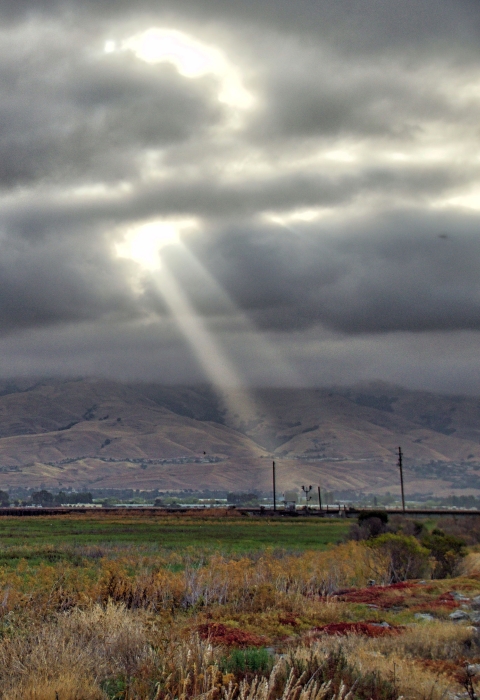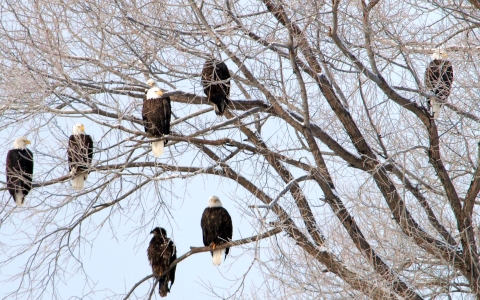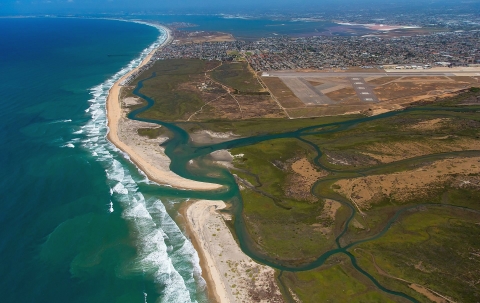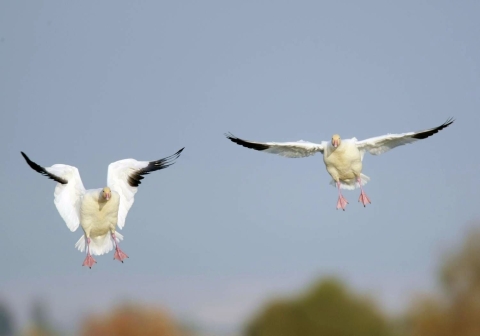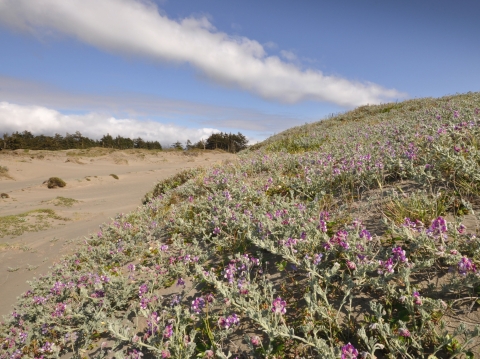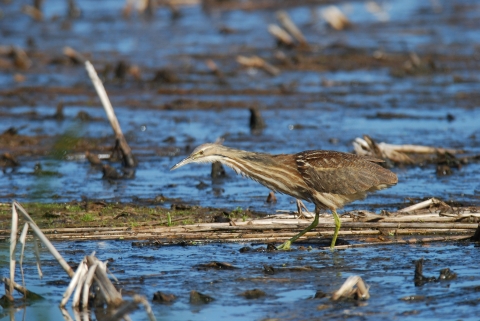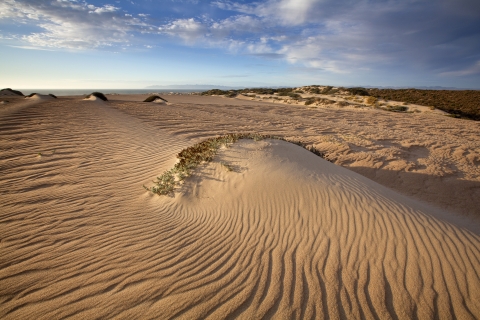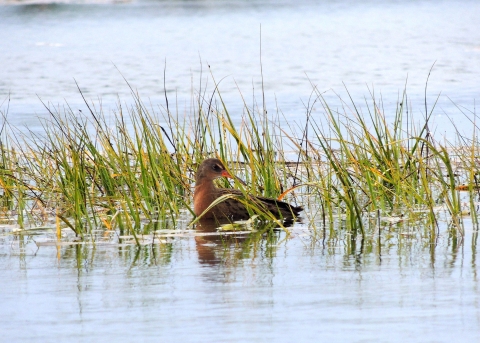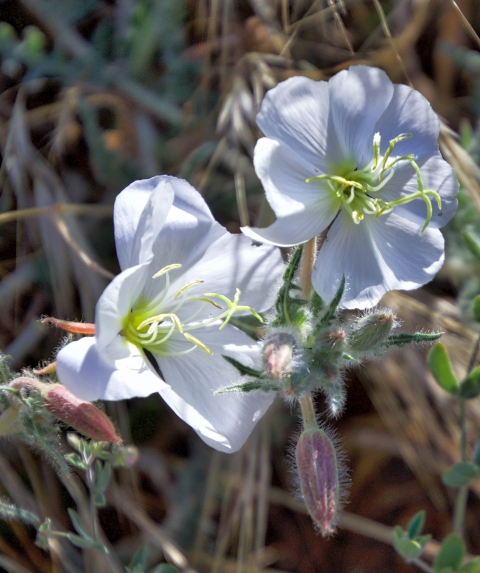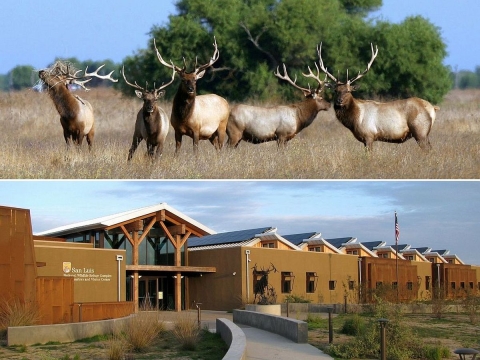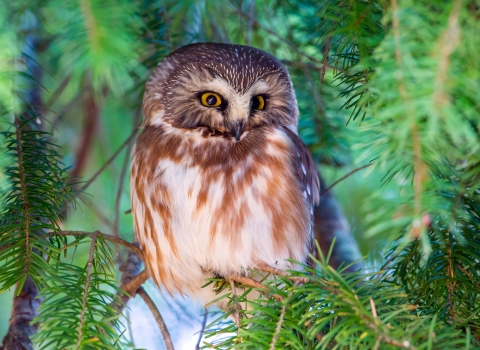No wonder California is called the Golden State. Look at that burst of natural light through the clouds over Don Edwards San Francisco Bay National Wildlife Refuge above.
The refuge, just minutes from the world headquarters of Google, Facebook and other high-tech giants, offers a variety of wildlife-related recreation opportunities, including 30 miles of walking trails. It’s a great place to visit year-round.
Don Edwards San Francisco Bay is one of three dozen national wildlife refuges managed by the U.S. Fish and Wildlife Service in California. The refuges are land and water set aside for fish, wildlife, plants and, ultimately, people. Please join us on a brief photographic tour of a few of them.
Lower Klamath National Wildlife Refuge, which straddles the Oregon-California state line, was established in 1908 by President Theodore Roosevelt as the nation’s first waterfowl refuge. With a backdrop of 14,000-foot Mount Shasta, in winter it is one of the finest places in the Lower 48 states to see bald eagles. See this “Winter at Klamath Basin National Wildlife Refuges” video.
If you’re visiting San Diego and looking for a touch of serenity, two pleasant places to consider are San Diego Bay National Wildlife Refuge and Tijuana Slough National Wildlife Refuge. Just 10-15 minutes south of downtown San Diego, the two refuges include flat walking trails near coastal wetlands that support tens of thousands of migratory birds each year. They are wonderful places to walk and photograph wildlife, all in view of the ocean or the bay. Keep up to date with recreation opportunities by liking the San Diego National Wildlife Refuges Facebook page.
Birds, birds, birds. Sacramento National Wildlife Refuge is in a prime spot along the Pacific Flyway of migratory birds. Each season brings a new look to the refuge. Peak waterfowl season is October through February; best viewing months are November and December, when visitors can see tens of thousands of ducks and geese. Year-round, you can drive the auto tour and enjoy the two-mile Wetland Walk. From February 15 to June 30, you can see colorful birds and wildflowers as you stroll five miles of Spring Trails.
Sacramento National Wildlife Refuge is one of the five national wildlife refuges and three wildlife management areas that make up the Sacramento National Wildlife Refuge Complex. They are Colusa National Wildlife Refuge, Delevan National Wildlife Refuge, Sacramento River National Wildlife Refuge, Sutter National Wildlife Refuge, the Butte Sink Unit of the Butte Sink Wildlife Management Area, the Llano Seco Unit of the North Central Valley Wildlife Management Area and Willow Creek-Lurline Wildlife Management Area.
Each January, the refuges help host the Snow Goose Festival of the Pacific Flyway.
Humboldt Bay National Wildlife Refuge is spread out over several units that include various habitats – from dunes to wetlands to forest.
Start your exploration at the visitor center in Loleta, California. Inside the center, you can learn about refuge visitor activities. You can pick up trail guides, wildlife lists and plant lists. The center also has stunning dioramas, interactive displays and a beautiful observation room equipped with spotting scopes and a Kids Corner full of books and activities.
Outside, a universally accessible deck and short boardwalk provide a wildlife observation area for all visitors, including those with mobility challenges. Or you can walk the Shore Loop Trail to an elevated observation deck, “The Flight Deck” (1.7 miles round trip).
Peak wildlife viewing is from November through March, but birds and other animals can be seen year-round.
The visitor center is named for the late Richard J. Guadagno, a former Humboldt Bay National Wildlife Refuge manager who died aboard United Flight 93 on September 11, 2001.
Pixley National Wildlife Refuge is important as habitat for rare and endangered species, including the blunt-nosed leopard lizard and the San Joaquin kit fox.
The refuge also supports at least 16 species of mammals and 13 species of reptiles and amphibians.
For visitors, in fall and winter, the refuge is the best place in the southern San Joaquin Valley to view majestic sandhill cranes. Cranes begin arriving from northern nesting grounds in September, and their numbers peak in January.
A 1.5-mile walking trail and wildlife observation deck are open from sunrise to sunset, seven days a week.
Guadalupe-Nipomo Dunes National Wildlife Refuge is in the heart of an 18-mile-long coastal dunes complex. The refuge, which is home to more than 120 species of rare plants and animals, covers almost two miles of beachfront, extending three miles inland. The dunes complex is recognized as a National Natural Landmark National Natural Landmark
The National Natural Landmarks Program preserves sites illustrating the geological and ecological character of the United States. The program aims to enhance the scientific and educational value of the preserved sites, strengthen public appreciation of natural history and foster a greater concern for the conservation of the nation’s natural heritage. The program was established in 1962 by administrative action under the authority of the Historic Sites Act of 1935. The first National Natural Landmarks were designated in 1963. Today, there are more than 600 National Natural Landmarks in 48 states, American Samoa, Guam, Puerto Rico and the U.S. Virgin Islands.
Learn more about National Natural Landmark . You can explore the dunes and the refuge on foot on the Oso Flaco and Rancho Guadalupe Trails. The trails are rigorous, and each is about four miles round trip.
Seal Beach National Wildlife Refuge is unusual. It is within an active military base, Naval Weapons Station Seal Beach. As a result, public access is extremely limited. The refuge, in Orange County, conserves coastal wetlands crucial to the survival of the endangered California least tern and light-footed clapper rail. It also serves as an island of habitat amid of a dense urban/suburban setting for a wide variety of fish, wildlife and plants, including migrating waterfowl, shorebirds and other water birds.
Because Bitter Creek National Wildlife Refuge is an important part of the California Condor Recovery Program, the refuge is closed to the public. However, large portions of it can be seen from Hudson Ranch Road, which bisects the refuge. The recovery program seeks to establish self-sustaining populations of California condors, which as a species were once down to 22 individual birds. There are now about 265 condors in the wild. One-hundred twenty-five or so of them inhabit the mountains near Bitter Creek National Wildlife Refuge and Hopper Mountain National Wildlife Refuge about 125 miles northwest of downtown Los Angeles.
Tiny, 55-acre Antioch Dunes National Wildlife Refuge, about 45 miles east of San Francisco, is the only national wildlife refuge national wildlife refuge
A national wildlife refuge is typically a contiguous area of land and water managed by the U.S. Fish and Wildlife Service for the conservation and, where appropriate, restoration of fish, wildlife and plant resources and their habitats for the benefit of present and future generations of Americans.
Learn more about national wildlife refuge in the country established to protect endangered plants and insects: the Contra Costa wallflower, Antioch Dunes evening primrose (left) and Lange’s metalmark butterfly (above).
Because the refuge is critical to these rare species, it is virtually closed to the public. It is open only for docent-led tours on the second Saturday of the month and to scientists, wildlife biologists and other researchers by appointment.
At San Luis National Wildlife Refuge near Los Banos in central California, there is an array of ways to see wildlife. At various times of the year, you can see the refuge’s famous tule elk on a five-mile auto tour route or you can see large concentrations of birds on the 8.5-mile waterfowl auto tour route. Additionally, you can walk any of the refuge’s seven nature trails. Two of them start near the beautiful and environmentally exemplary visitor center, which is certified as LEED platinum.
The best time of year to see waterbirds is late fall through early spring. A great time to see tule elk is during the rut, or mating season – August through September – when males are bugling to defend their harem of females against other males (video).
